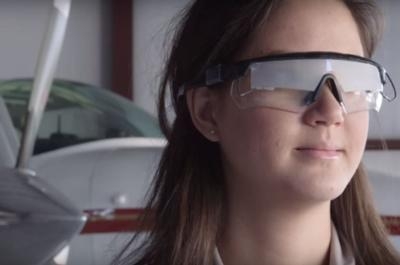High-Tech Training Aid Gaining Popularity
ICARUS Devices, a Wisconsin-based start-up founded by Nick Sinopoli in the wake of a friend’s aviation-related death, announced on 18 May 2023 that Amarillo, Texas-based air-ambulance operator Apollo MedFlight will presently integrate the Instrument Conditions Awareness Recognition and Understanding System (ICARUS) smart View-Limiting Device (VLD) into its pilot training curriculum.

A leading regional air-ambulance concern with bases in Texas, Oklahoma, South Dakota, North Carolina, Wisconsin, Louisiana, and Nebraska, Apollo MedFlight operates a diverse fleet comprising Bell’s 407 and 429, and Airbus’s EC-135 and 145 model helicopters; as well as Pilatus’s PC-12 single-engine turboprop and Textron/Beechcraft’s storied King Air twin-turboprop fixed-wing aircraft.
Apollo MedFlight Chief Pilot Art Connolly stated: “We knew the first time we utilized the ICARUS Device in our helicopters that they were a game-changer not only for the level of training and proficiency, but also for the comfort level of our pilots and clinicians. Using the device in the fixed-wing will allow us to take training to a level only previously available in a simulator.”
View Limiting Devices (VLD) such as the ICARUS smart visor are utilized by civilian Certified Flight Instructors/Instrument (CFIIs) and military Instructor Pilots (IPs) to train student pilots in the high art of competently controlling and navigating aircraft solely by reference to flight-instruments under Instrument Meteorological Conditions (IMC)—such as those occasioned by clouds, fog, haze, heavy rain, blowing snow, and dust.
By virtue of its ability to rapidly change opacity, the ICARUS smart VLD allows flight-instructors to alter student pilots’ in-flight visibility, thereby creating dynamic, scenario-based flight-training environments. The ICARUS device's polymer dispersed liquid-crystal visor cutout is controlled by an App or manually via a power control unit manipulated by the CFII/IP. The device can be tailored to any airframe and weighs a scant 2.5-ounces.
Developed in 2014 and patented in 2016, the ICARUS device is currently utilized by numerous civilian flight-schools, law-enforcement agencies, and Part 135 air-taxi and air-ambulance operators. Whether applied to primary IFR training or professional pilots’ recurrent training events, the ICARUS device is eminently effective and conducive to use in aircraft as disparate as Cessna’s 172 Skyhawk, Gulfstream’s G-650, and the U.S. Army’s LUH-72A Lakota.
The ICARUS device significantly improves three key aspects of instrument training. During Inadvertent Instrument Meteorological Conditions (IIMC) training events, ICARUS simulates rapid reductions in pilot visibility, thereby evoking the startle effect and forcing emergency transitions to instrument flight. Secondly, the ICARUS device enhances IFR proficiency by mimicking real world weather conditions during practice IFR approaches. Finally, by replicating marginal visibility conditions, the ICARUS device allows CFIIs/IPs to assess students’ IFR decision-making skills—a salient component of Pilot-in-Command (PIC) check rides.

The ICARUS Night Vision Goggle (NVG) compatible visor attaches to the ends of standard, binocular NVG tubes and weighs just a 1/10th of a pound. The NVG compatible model utilizes the same power control unit and App as the standard ICARUS Device.
At a per-unit cost of $1,250, the ICARUS device is within the fiscal purview of even small flight-schools. What’s more, the system’s superiority to conventional IFR training hoods—dove-gray horrors despised in equal measure by the greenest student-pilots and saltiest ATPs —is apt to spark interest and enthusiasm amongst both instrument students and CFIIs, in so doing, driving up flying hours, training quality, check-ride performance, and bottom-line.
 ANN FAQ: Contributing To Aero-TV
ANN FAQ: Contributing To Aero-TV Aero-News: Quote of the Day (12.10.25)
Aero-News: Quote of the Day (12.10.25) ANN's Daily Aero-Term (12.10.25): North Atlantic High Level Airspace (NAT HLA)
ANN's Daily Aero-Term (12.10.25): North Atlantic High Level Airspace (NAT HLA) Airborne 12.08.25: Samaritans Purse Hijack, FAA Med Relief, China Rocket Fail
Airborne 12.08.25: Samaritans Purse Hijack, FAA Med Relief, China Rocket Fail Airborne-Flight Training 12.04.25: Ldg Fee Danger, Av Mental Health, PC-7 MKX
Airborne-Flight Training 12.04.25: Ldg Fee Danger, Av Mental Health, PC-7 MKX




